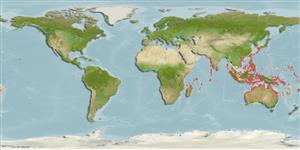>
Gobiiformes (Gobies) >
Gobiidae (Gobies) > Gobiinae
Etymology: Barbuligobius: Latin barba,-ae; barbula = beard + Latin, gobius = gudgeon (Ref. 45335).
More on authors: Lachner & McKinney.
Environment: milieu / climate zone / depth range / distribution range
Ökologie
seewasser demersal; tiefenbereich 1 - 15 m (Ref. 90102). Tropical
Indo-West Pacific.
Size / Gewicht / Alter
Maturity: Lm ? range ? - ? cm
Max length : 2.0 cm SL Männchen/unbestimmt; (Ref. 559)
Rückenflossenstacheln (insgesamt): 7; Rückenflossenweichstrahlen (insgesamt): 8-9; Afterflossenstacheln 1; Afterflossenweichstrahlen: 8 - 9. Characterized by light tan body color with row of five horizontally elongate black spots along middle of side; presence of row of smaller dark spots along lower side of body; nape, back and upper caudal peduncle with six brown saddles; joined pelvic fins, relatively long , extends beyond anal fin; rounded caudal fin; longitudinal scale series 23-25; absence of scales on nape, cheek, opercle, breast and anterior body; numerous, elongate, fleshy barbels and flaps on head; depth of body 5.6-6.3 in SL (Ref. 90102).
Inhabits sand-rubble bottoms, usually in surge channels or on exposed outer edge of reefs in 1-15 m (Ref. 90102). Burrows in sand adjacent to coral or rock (Ref. 2798).
Life cycle and mating behavior
Geschlechtsreife | Fortpflanzung | Ablaichen | Eier | Fecundity | Larven
Hoese, D.F., 1986. Gobiidae. p. 774-807. In M.M. Smith and P.C. Heemstra (eds.) Smiths' sea fishes. Springer-Verlag, Berlin. (Ref. 2798)
IUCN Rote Liste Status (Ref. 130435)
Bedrohung für Menschen
Harmless
Nutzung durch Menschen
Mehr Information
NamenSynonymeMetabolismusRäuberÖkotoxikologieFortpflanzungGeschlechtsreifeAblaichenSpawning aggregationFecundityEierEientwicklung
ReferenzenAquakulturAquakultur ProfilZuchtlinienGenetikElectrophoresesVererbbarkeitKrankheitenVerarbeitungNutrientsMass conversion
PartnerBilderStamps, Coins Misc.LauteCiguateraGeschwindigkeitSchwimmstilKiemenoberflächeOtolithsGehirngrößeSehfähigkeit
Tools
Zusatzinformationen
Download XML
Internet Quellen
Estimates based on models
Preferred temperature (Ref.
123201): 22 - 29.3, mean 28.3 °C (based on 2614 cells).
Phylogenetic diversity index (Ref.
82804): PD
50 = 1.0000 [Uniqueness, from 0.5 = low to 2.0 = high].
Bayesian length-weight: a=0.01023 (0.00477 - 0.02194), b=3.02 (2.84 - 3.20), in cm total length, based on LWR estimates for this (Sub)family-body shape (Ref.
93245).
Trophic level (Ref.
69278): 3.0 ±0.3 se; based on size and trophs of closest relatives
Widerstandsfähigkeit (Ref.
120179): hoch, Verdopplung der Population dauert weniger als 15 Monate. (Preliminary K or Fecundity.).
Fishing Vulnerability (Ref.
59153): Low vulnerability (10 of 100).
